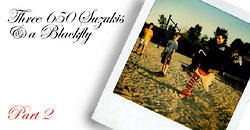
|
|
||||||||
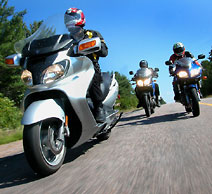 |
|
Three Suzukis and a Blackfly. |
I wake up at 7 a.m. I'm in a motel room with a freshly showered Mr. Seck doing the wakey-wakey chant. Then comes the realization that I'm about to embark on a 12-hour endurance ride around the back-end of northern Ontario in search of obscure clues in obscure places for some kind of obscure pleasure. Welcome to the Blackfly Rally – 12 or 24 hours of non-stop riding to test man and machine with no plausible reason other than to ride … a lot.
At least I was here with the CMG crew for another purpose – to see how three very different machines could cope with 12 hours of continuous riding. Oh, and maybe not come in last either.
The machines in question were all from the Suzuki stable, all twins and all of 650 cc displacement. But that's where the similarity ends, as we had one sporty(ish) bike (SV650), one dual-sport (DL 650 V-Strom) and one maxi-scooter (650 Burgman).
Three bikes to test, a minimum of 800 km to cover and all within 12 hours … this would be somewhat of a challenge.
If you read last week's feature article then you'll know all about how the Rally part of the ride worked out. This week it's time to look at how the testing bit worked out, with part 2 of three Suzukis and a Blackfly …
650, 650, 650
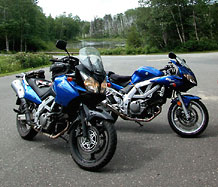 |
|
SV and DL are both powered by essentially the same v-twins. |
Bar a few cc's difference, all three motors of our Suzuki trio are pretty much the same size, the difference being in their state of tune and configuration.
The SV and DL use essentially the same 90 degree v-twin unit, with the SV having an extra 7 hp up top (thanks to different cams), along with a lighter crank (for quicker revving, but less plodability) and taller overall gearing (more speed, but less pull).
In contrast, the Burgman has a parallel twin motor tuned for … er, scootering? I don't know, there's not much to compare it to here, but since it never really seemed to rev much above 7,500 rpm, I'd assume that it's not an overly tuned unit.
Out on the roads of the Blackfly Rally it was really as you'd expect – the SV being notable for its quick revving and higher surges of power, the DL being not far behind, but also happy to plod along, and the Burgman whirring along all day at a steady rpm (thanks to the CVT transmission).
 |
|
Workhorse (left) and stallion (right). |
Character-wise, the SV is like an eager stallion, chomping at the bit, with a real galloping feel to the way it lays down its power under acceleration. The DL takes more of a workhorse attitude, but still with a good turn of speed hidden behind its relaxed and friendly nature. They're typical v-twin by nature, even down to the slight primary vibration, which only serves to emphasize that v-twin character and make the rider feel intimately connected to the motor below.
And what about the Burgman? Well, it's hard to separate the motor from the transmission as the constantly variable transmission (CVT) means that the motor will quickly spin up to a certain rpm and hold it there – using the variable gearing to alter the bike's speed from there on.
Although all very clever, this ultimately means that the rider is a bit disconnected from the motor's base character. Combine the CVT effect with a fitted balance shaft, and the whole thing feels a bit like a blender/electric motor, it's that smooth. Not a bad thing by any means, but a very different experience from the other two bikes.
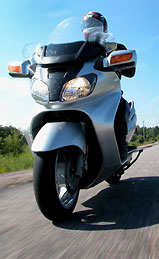 |
|
"Neeeeeeee". The Burgman's almost electric. |
What makes the 650 Burgman somewhat unique in the maxi-scooter world is that it also comes with a ‘power' mode button that gives the whole experience a bit more oomph by allowing the revs to rise to 7,500 rpm instead of the standard 5,500.
To be honest, I didn't find much of a difference between the two modes, and I was a tad disappointed to discover that the Burgy (if I may call it that) proved unable to spin wheels or pop wheelies in the power setting. Needless to say, it still spent most of its 12 hours in this mode, which would eventually see a top speed of about 165 km/h, albeit under leisurely acceleration once you got past that 7,500 rpm mark.
There's also a ‘manual' option that allows the rider to use two buttons to go up and down through the “gearbox”. Of course, this is about as real as Pamela Anderson's tits, since the five speeds are just preset ratios in the CVT box. Although it works fine, it seemed a bit pointless, since all you were doing was adding a jerky change between an otherwise smooth ratio transition.
All these options also add an overwhelming choice of buttons on the left hand side switchgear. I'm sure you'd get used to what does what eventually, but initially it means that you have to pause every time you want to use something, just to consider your choices.
 |
|
Burgy's got loads o' storage space. Once we'd got through the beer, gas sniffing ensued ... |
Once you're past the switchgear confusion, the ease of the Burgman certainly made for a less challenging ride, something that you'd expect maybe a godsend on such a long haul. Well, yes and no. On the open highway, on a standard geared machine, you ultimately end up cruising along in top anyway, so automation doesn't make a difference. Although towards the end of the day, especially when we hit built-up areas, yes, it was rather nice to just twist and go.
In general riding, the Burgman kept up with the other two just fine, although whoever was riding it after stops, generally had to eat the dust from the other two bikes during the spirited take offs. Well, at least it had a tall screen ...
CHASSIS
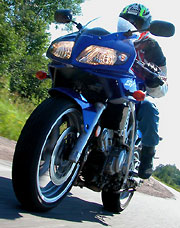 |
|
When the map showed twisties ahead, the SV became the bike to have. |
The SV is the sportiest of the bunch and as such proved to be the most flickable (it's the lightest of the lot) and easy to ride thanks to its overall nimbleness. It was the bike to have when it came to any twisty bits, as it would hold its line well at speed and have the upper-end power to boot. Problems came when the road got rough (relatively common on the northern Ontario back roads), where the SV would transfer the bigger irregularities right to the rider.
Although the SV feels quite small, I found that I could still fit my knees nicely within the tank cutaways and comfort was not nearly as contorting as the more aggressive 600 supersports. It's also less intimidating than its sportier brethren, meaning that you can wind it out without feeling that you're going to lose control if you're not paying attention 100%. I like that.
Brakes are good too, although maybe a tad too aggressive, as they would come on strong quickly, making a controlled stoppie somewhat of a fearful escapade.
 |
|
Soft and long-travel DL suspension was the happiest when the road went to shit. |
Where the SV got tied in knots over bumps, the softer suspended DL took it all in its stride, while still holding well in higher speed corners, albeit without the more exacting precision of the SV.
While the DL does come with an additional 21 Kg (dry) over the SV, it's not a pig by any means, agility aided by its wide bars that made turning it in a breeze. This, and its tall posture, also made it a pleasure around town – somewhere where the sporty SV became a bit more of a liability.
The Burgman proved to have surprisingly compliant suspension, holding its line really well into corners and absorbing the bumpy stuff better than the SV, albeit marginally. Where it did fall down (although not literally) was its tendency for the small wheels to drop into large holes, which would immediately over-power the suspension and send a big shock to the rider, made worse by their inability to take some of it through their (forward positioned) legs.
 |
|
The Burgy had nowt to clamp onto. |
Another scooter-specific oddity comes with high-speed cornering, where you find yourself cranking it over but unable to use your body to pull it in, as there's simply nothing in between you legs to lever against. Still, someone claimed to have seen 160 under these circumstances and had lived to tell the tale, so it's obviously capable of such.
With a hefty 238Kg of mass to cope with, the Burgman is significantly heavier than the other two, but by carrying that weight low down, it maintains a goodly amount of prowess – thankfully kept in order with the capable twin discs up front.
ERGI, ERGA, ERGO
 |
|
SV - not particularly comfy after a while. |
Even though the sporty positioning of the SV isn't too radical, a good torso-supporting wind blast off the low screen helps to keep the weight off the wrists at speed, but not in town. The seat is also quite hard, with about two hours usage before you start to go numb. We opted to put the Airhawk cushion on it, which helped immensely, but was ultimately unable to make the SV a bike of choice as the day progressed – save for the occasional twisty section.
Comfort wise, we'd all thought that the Burgy would be the one we'd all be fighting over as the day got on and the body started to complain. Not so. Its feet forward, locked-in position made it not that much better than the SV, just with different numb bits.
 |
|
Looks can be deceiving as the Burgman wasn't the lazy-boy that it appeared to be. |
This was a bit of a surprise, as it looks supremely comfortable and even comes with an adjustable (lower) backrest for the rider, but this also limits how far you can push rearwards too. I suspect that a lot of the comfort problems were due to being outside its designed height limitations (i.e. not for over 6 footers).
There were also some complaints of head buffeting and a weird back-draft that pushed on you forwards from behind. Unfortunately, the screen is non adjustable to counter any of this, and although it was relatively easy to peer over it, the view of the road immediately afore was a tad distorted.
The DL walked away with the comfort prize – upright and relatively spacious, you could ride this thing all day – slow or fast – and still be the first one to the bar while your colleagues were still nursing numb parts and aching limbs in their motel room.
12 HOUR COMFORT CONCLUSIONS
 |
|
Can't touch this! The V-Strom was the ultimate long-distance ride of them all. |
The obvious opposing ends of our spectrum here are the SV650 and Burgman. The SV is a not-too-aggressive sport riding position with feet tucked slightly rearwards and bars down, whereas the Burgman is more cruiser like with its feet-forward and bars pulled back.
Both have their spots of uncomfortableness – the SV causing shoulders, wrists and knees to ache after a while, whereas the Burgman would test your neck muscles and lower back. As a result, switching between the two proved to be rather blissful, as what ached on one was then allowed to relax on the other.
If only they could make a Transformer version of the two, we'd be laughing. Of course, the V-Strom, with its ample legroom and ideal positioning, did that without the need for a whole new engineering concept, and so topped them all by a long way in the long-haul comfort world.
I've said it before, and I'll say it again, it's just a perfect all-rounder.
Wondering how the SV and DL would stack up if pitched against each other on a race track? We did too – click here for the results.
COMPARITOR
|
Specifications |
SV 650 | DL 650 | Burgman 650 |
Comments |
|
MSRP |
$8,799.00 | $8,999.00 | $10,999.00 |
I
would have expected the SV and the DL to be the same, but there
as good as. Burgman wants an extra two grand. Is that too much?
|
|
Displacement |
645 cc | 645 cc | 638 cc |
Much
of a muchness.
|
|
Engine type |
dohc v-twin, liquid-cooled | dohc v-twin, liquid-cooled | Inline dohc twin, liquid-cooled |
The
SV and DL share essentially the same motors in different states
of tune. Burgman puts its pots inline.
|
|
Carburetion |
Fuel Injection | Fuel Injection | Fuel Injection |
Pretty
much the norm these days.
|
|
Final drive |
Six-speed, chain-drive | Six-speed, chain-drive | Electronically-controlled, CVT-automatic + 5-speed |
SV
and DL are a pretty standard set-up, whereas the Burgman (like all
maxi-scooters) goes CVT-automatic, with the notable exception of
a "5 speed" imitation via "up and down" buttons.
|
|
Tires, front |
120/60 ZR17 | 110/80 R19 | 120/70 R15 |
Dual-sports
need a large front wheel for going over bumps. Scooters need small
wheels, because ...
|
|
Tires, rear |
160/60 ZR17 | 150/70 R17 | 160/60 R14 | |
|
Brakes, front |
Dual 290 mm discs with two-piston calipers | Dual 310 mm discs with two-piston calipers | Dual 260 mm discs with two-piston calipers |
It doesn't seem to make sense that the DL discs are bigger yet the SV's better. Well, apart from the SV being lighter. Hmhh. Different pads? Burgman has respectable specs which also work well in actuality. |
|
Brakes, rear |
Single 240 mm disc with single-piston caliper | Single 260 mm disc with single-piston caliper | Single 250 mm disc | |
|
Seat height |
800 mm (31.5") | 820 mm (32.3") | 750 mm (29.5") |
The
SV is really quite tall. Shorties will like the Burgman.
|
|
Wheelbase |
1,430 mm (56.3") | 1,540 mm (60.6") | 1,595 mm (62.8") |
Sport
= small (quicker turning), cruise = large (highway stability).
|
|
Dry
weight |
169 Kg (372 lbs) | 190 Kg (418 lbs) | 238 Kg (524 lbs) |
As
expected the sportiest bike (SV) weighs in lightest, getting progressively
heavier as you err away from sport-mode (Burgman).
|
|
Colours |
Silver, Blue | Silver, Blue | Silver, Dark Blue |
Any
colour you want ... so long as it's silver or blue.
|
|
Performance |
SV 650 | DL 650 | Burgman 650 |
Comments |
| Fuel economy |
16.8
km/l |
16.9
km/l |
17.2
km/l |
The DL and SV are almost identical. Although the SV motor's in a higher state of tune, because the bikes weren't really thrashed (much), the fuel economy doesn't differentiate. Burgman gets a slightly better rate, but not much in any of it. |
| Tank capacity |
17
litres
|
22
litres
|
15
litres
|
The DL's got a way bigger tank and so can eat up many more miles before being forced to stop for a drink. Comfort factor will probably help you get it there too. Small tanked Burgman still manages to stay respectable. |
| Fuel range |
286 km
|
372 km
|
258 km
|
|
| Warranty |
12
months |
12
months
Unlimited km |
12
months
Unlimited km |
All Suzukis, so they're all the same. |
![]()